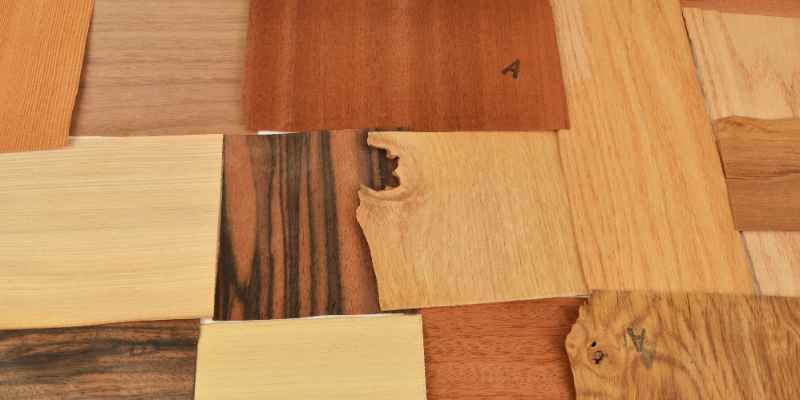To identify walnut wood, look for slight variations in coloring, ranging from creamy white to dark chocolate brown. The heartwood is the most popular, known for its dark brown color and smooth finish.
Walnut also develops a lustrous patina over time, making it unique among domestic wood species. Its grains are generally straight and tight, with attractive swirls, knots, burls, and curls. When differentiating walnut from other woods, note that it has a more modern and bold vibe compared to mahogany, which has a deep reddish-brown color for a classic and antique look.
Additionally, purchasing walnut wood furniture from a reputable maker is the best way to ensure its authenticity.
Introduction To Walnut Wood
Walnut wood is a popular choice for furniture and woodworking due to its attractive appearance and desirable characteristics. In this article, we will explore the various aspects of walnut wood, including its popularity, different varieties, and how to identify it.
The Popularity Of Walnut
Walnut wood is highly sought after for its rich, dark chocolate brown color and smooth finish. Its versatility and durability make it a preferred choice for crafting high-quality furniture, flooring, and decorative items.
Walnut Wood Varieties
There are several varieties of walnut wood, including American walnut and European walnut. Each variety possesses distinct characteristics in terms of color, grain patterns, and suitability for different woodworking projects.
Physical Properties Of Walnut Wood
Walnut wood can be identified by its physical properties. It has a dark chocolate brown color, with slight variations in coloring throughout. The wood has straight and tight grains, often with attractive swirls and wave patterns like wood knots, burls, and curls.
It polishes to a smooth finish and develops a lustrous patina over time.
Heartwood And Sapwood
Walnut wood is known for its distinct heartwood and sapwood. The heartwood, which is the darker part of the wood, is the most popular and commonly used in hardwood products. It has a dark chocolate brown color that adds to its beauty. The sapwood, on the other hand, is lighter in color, ranging from creamy white to light brown. Both heartwood and sapwood can be used, depending on preference or project.
Color And Patina Development
Walnut wood has a unique color that ranges from creamy white in the sapwood to a dark chocolate in the heartwood. Over the years, natural walnut wood develops a lustrous patina that adds to its charm and beauty. This is due to the wood’s exposure to air, light, and other environmental factors. As the only dark-brown domestic wood species, it has a large following of devoted woodworkers and fine furniture aficionados.
In conclusion, identifying walnut wood can be a bit challenging. However, understanding its physical properties such as heartwood and sapwood, color, and patina development can help you identify it with ease. Whether you’re a woodworker or a furniture enthusiast, walnut wood is a great choice for your projects.
Grain Patterns And Textures
When it comes to identifying walnut wood, one of the key factors to consider is its grain patterns and textures. Understanding these characteristics can help you determine whether the wood you are examining is indeed walnut.
Straight And Tight Grains
Walnut wood typically exhibits straight and tight grain patterns. The grains run parallel to each other, creating a uniform and sleek appearance. This distinctive feature sets walnut apart from other types of wood, such as oak or mahogany, which may have more pronounced grain patterns.
Moreover, the tightness of the grains in walnut wood contributes to its strength and durability. It is known for its resistance to warping or twisting, making it an ideal choice for furniture and woodworking projects.
Swirls, Burls, And Curls
In addition to straight and tight grains, walnut wood can also display swirls, burls, and curls. These unique patterns add depth and character to the wood, enhancing its aesthetic appeal.
Swirls, which appear as gentle curves or waves in the grain, create an elegant and sophisticated look. Burls, on the other hand, are rounded growths on the tree that result in intricate patterns when the wood is cut. Curls, also known as figure or fiddleback, are wavy lines that create a three-dimensional effect.
These natural variations in the grain patterns give walnut wood a distinct and captivating appearance, making it a sought-after choice for high-quality furniture and decorative items.
By carefully examining the grain patterns and textures, you can confidently identify walnut wood and appreciate its unique beauty and versatility.
Distinguishing Walnut From Other Woods
When it comes to identifying walnut wood, it’s essential to know how to distinguish it from other types of wood. Walnut has its unique characteristics that set it apart from other species, such as mahogany and other domestic woods. In this section, we will compare walnut with mahogany and other domestic species, highlighting the key differences.
Comparing Walnut And Mahogany
Walnut and mahogany are both popular choices for furniture and woodworking projects, but they have distinct differences. Here’s how you can tell them apart:
| Walnut | Mahogany |
|---|---|
| Color ranges from light brown to dark chocolate brown | Sports a deep reddish-brown color |
| Modern and bold vibe | Classic and antique look |
Walnut Vs. Other Domestic Species
Walnut also differs from other domestic species in terms of its characteristics. Here’s how you can distinguish walnut from other woods:
- Color: Walnut has slight variations of coloring throughout, with dark chocolate brown heartwood being the most popular.
- Grain: It polishes to a very smooth finish, and the grain patterns are unique and distinctive.
- Hardness: Walnut is a hardwood with excellent durability and strength.
- Patina: Over the years, natural walnut wood develops a lustrous patina, adding to its beauty.
By understanding these distinguishing features, you can confidently identify walnut wood and appreciate its unique qualities.
Practical Identification Tips

Are you looking for practical tips on how to identify walnut wood? Look no further! Walnut wood typically has straight and tight grains, with attractive swirls and wave patterns, including knots, burls, and curls. The color ranges from creamy white in the sapwood to a rich dark chocolate brown in the heartwood.
It is a popular choice for hardwood products due to its unique variations and lustrous patina.
Identifying walnut wood can be a bit tricky if you are not familiar with its characteristics. However, there are some practical identification tips that you can follow to identify walnut wood accurately. In this section, we will discuss two essential methods that you can use to identify walnut wood: using water to reveal grains and examining cross-sections.
Using Water to Reveal Grains
One of the easiest ways to identify walnut wood is to use water to reveal the wood’s grains. When you wet the wood’s surface, the grains become more visible and prominent. Here is how you can use water to identify walnut wood:
1. Sand the surface of the wood to remove any dirt, dust, or debris.
2. Pour a small amount of water onto the surface of the wood.
3. Observe the wood’s grains. If the grains appear straight and have a dark brown or black color, then it is likely that the wood is walnut.
Examining Cross Sections
Another way to identify walnut wood is to examine the wood’s cross-sections. Cross-sections are cuts of the wood that show the wood’s interior structure. Here is how you can examine cross-sections to identify walnut wood:
1. Cut a small piece of the wood to create a cross-section.
2. Observe the wood’s color. Walnut wood has a dark chocolate brown color with light-colored sapwood.
3. Look at the wood’s grain pattern. Walnut wood has a straight grain pattern with occasional waves.
4. Check for any visible pores. Walnut wood has small, visible pores that are not as noticeable as other types of wood.
By following these practical identification tips, you can easily identify walnut wood and distinguish it from other types of wood. Whether you are a woodworker or a furniture enthusiast, knowing how to identify walnut wood can help you make more informed decisions when working with wood.
Furniture And Walnut Wood
When it comes to furniture, walnut wood is a popular choice due to its rich color and elegant appearance. Identifying walnut in furniture is essential for both buyers and sellers to ensure authenticity and quality.
Identifying Walnut In Furniture
Walnut wood in furniture can be identified by its distinct characteristics such as a dark chocolate brown color, creamy white sapwood, and a smooth finish that develops a lustrous patina over time.
Reputable Makers And Authenticity
Authentic walnut furniture is often crafted by reputable makers known for their expertise in working with this premium wood. Look for subtle color variations and unique graining patterns to ensure the authenticity of walnut furniture pieces.
The Walnut Tree’s Telltale Signs
Walnut wood can be identified by its physical characteristics such as slight variations in color throughout the heartwood and sapwood, which ranges from creamy white to dark chocolate brown. Additionally, the wood has straight and tight grains with attractive swirls and wave patterning in the form of knots, burls, and curls.
To identify walnut furniture, look for color variations, graining patterns, and burled walnut.
Buds And Leaves
Walnut trees have alternate branching, with pinnate leaves and oval-shaped leaflets.
Bark And Nuts
The bark of walnut trees is dark and rough, with deep furrows and ridges. The nuts are round and enclosed in a green husk.
Wildlife Interaction
Various animals, such as squirrels and birds, are attracted to walnut trees for their nuts, aiding in seed dispersal.
Caring For And Polishing Walnut
Walnut wood boasts a smooth finish that ranges from creamy white to dark chocolate brown. As time passes, it develops a beautiful lustrous patina that enhances its natural beauty.
Smooth Finish Techniques
- Use fine-grit sandpaper to smooth the surface
- Apply wood conditioner to enhance the grain
- Finish with a high-quality wood polish
Maintaining The Lustrous Patina
- Regularly dust with a soft cloth to remove debris
- Avoid direct sunlight to prevent fading
- Use a gentle wood cleaner for routine maintenance
Sustainability And Sourcing
Identifying walnut wood involves recognizing its rich dark chocolate brown heartwood and creamy white sapwood. The wood polishes to a smooth finish and develops a lustrous patina over time, making it a popular choice for fine furniture and woodworking projects.
American walnut typically features straight and tight grains with attractive swirls and wave patterns, offering a distinctive and elegant appearance.
Environmental Impact
Walnut wood is known for its sustainability due to the responsible sourcing practices.
Choosing Sustainable Walnut Wood
When selecting walnut wood, look for certifications like FSC to ensure sustainability.
Common Uses And Applications
To identify walnut wood, look for variations in color, ranging from creamy white to dark chocolate brown in the heartwood. The grain is straight and tight, with attractive swirls and wave patterns, often seen in the form of knots, burls, and curls.
Additionally, walnut develops a lustrous patina over time, making it easily distinguishable.
Walnut wood is a popular choice for a wide range of applications due to its beautiful color and grain pattern, as well as its durability. From furniture to flooring, walnut wood is a versatile material that can add a touch of elegance to any space.
Walnut in Woodworking
Walnut wood is a favorite among woodworkers due to its strength and workability. It is commonly used for high-end furniture, cabinetry, and decorative items such as bowls and cutting boards. The wood’s rich, dark color and unique grain patterns make it a popular choice for creating one-of-a-kind pieces.
Walnut in Interior Design
In interior design, walnut wood is often used for flooring, paneling, and trim work. Its warm, inviting color adds a touch of sophistication to any room. Walnut wood furniture is also a popular choice, as it can add a sense of elegance and class to any space.
Overall, identifying walnut wood can be a challenge, but its beauty and durability make it a popular choice for a wide range of applications. Whether you’re a woodworker or an interior designer, walnut wood is sure to add a touch of luxury to your next project.

Frequently Asked Questions
How Do You Know If Wood Is Walnut?
To identify walnut wood, look for slight variations in color, ranging from creamy white in the sapwood to a dark chocolate brown in the heartwood. Walnut has straight and tight grains with attractive swirls, knots, burls, and curls. It polishes to a smooth finish and develops a lustrous patina over time.
Reputable furniture makers are a reliable source for authentic walnut wood furniture.
What Does Walnut Lumber Look Like?
Walnut lumber has variations in color, ranging from creamy white in the sapwood to dark chocolate in the heartwood. It polishes to a smooth finish and develops a lustrous patina over time. The grain is straight and tight, with attractive swirls, knots, burls, and curls.
How To Identify A Walnut?
To identify a walnut, look for dark chocolate brown heartwood and creamy white sapwood. The wood may have straight, tight grains with swirls, knots, burls, and curls. It polishes to a smooth finish and develops a lustrous patina over time.
How To Tell The Difference Between Mahogany And Walnut?
To differentiate between mahogany and walnut, mahogany has a deep reddish-brown color, giving furniture a classic and antique look. Walnut, on the other hand, has a modern and bolder vibe, with colors ranging from light brown to dark chocolate brown.
American walnut has straight and tight grains with attractive swirls, knots, burls, and curls. To be sure, purchase furniture from a reputable maker who uses real walnut wood.
Conclusion
Identifying walnut wood can be done by observing its key features such as the color variations, ranging from creamy white in the sapwood to dark chocolate in the heartwood. Walnut wood also develops a lustrous patina over time. Additionally, the grain patterns of walnut, including swirls and wave patterning, are unique and distinguishable.
By considering these characteristics, one can easily identify walnut wood and appreciate its beauty in various furniture and woodworking projects.

